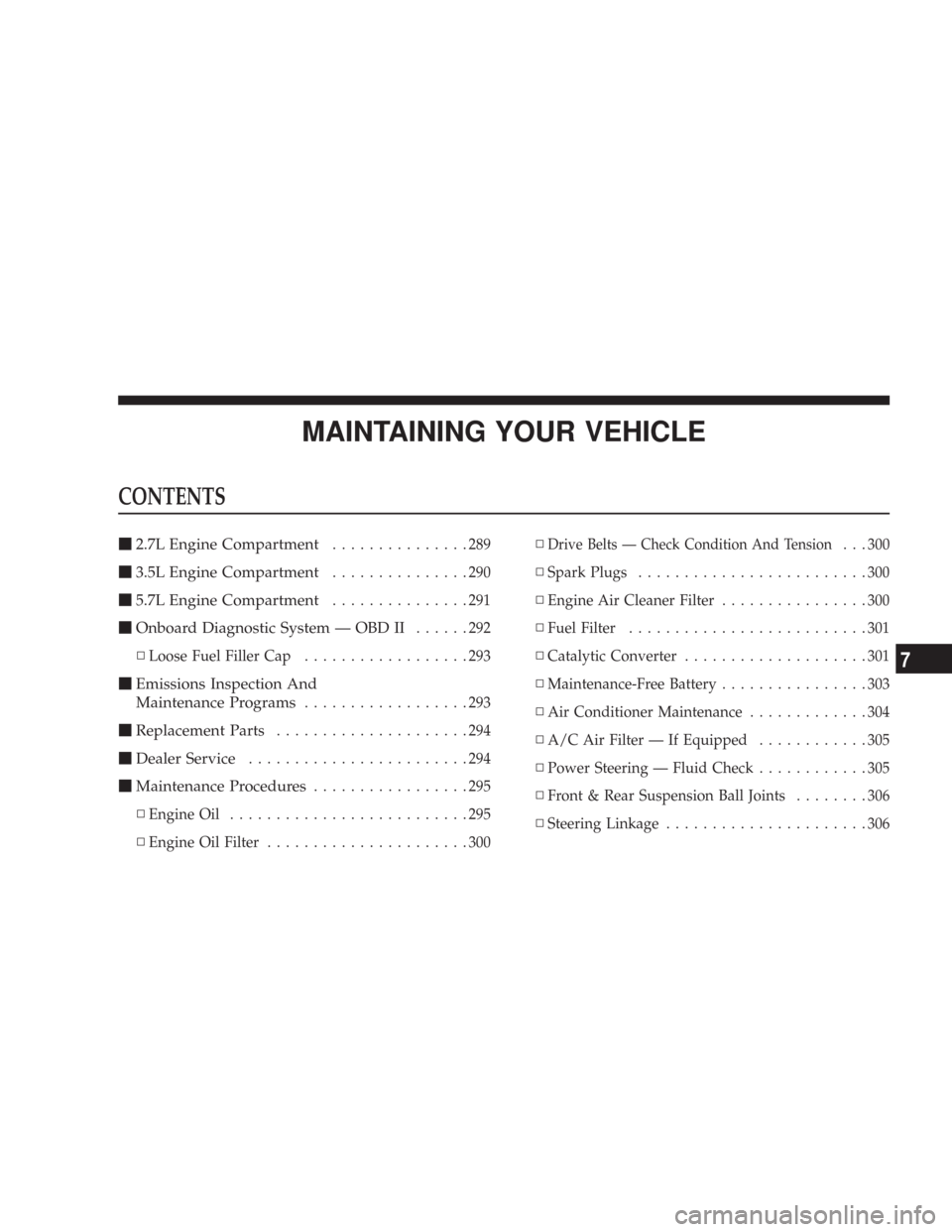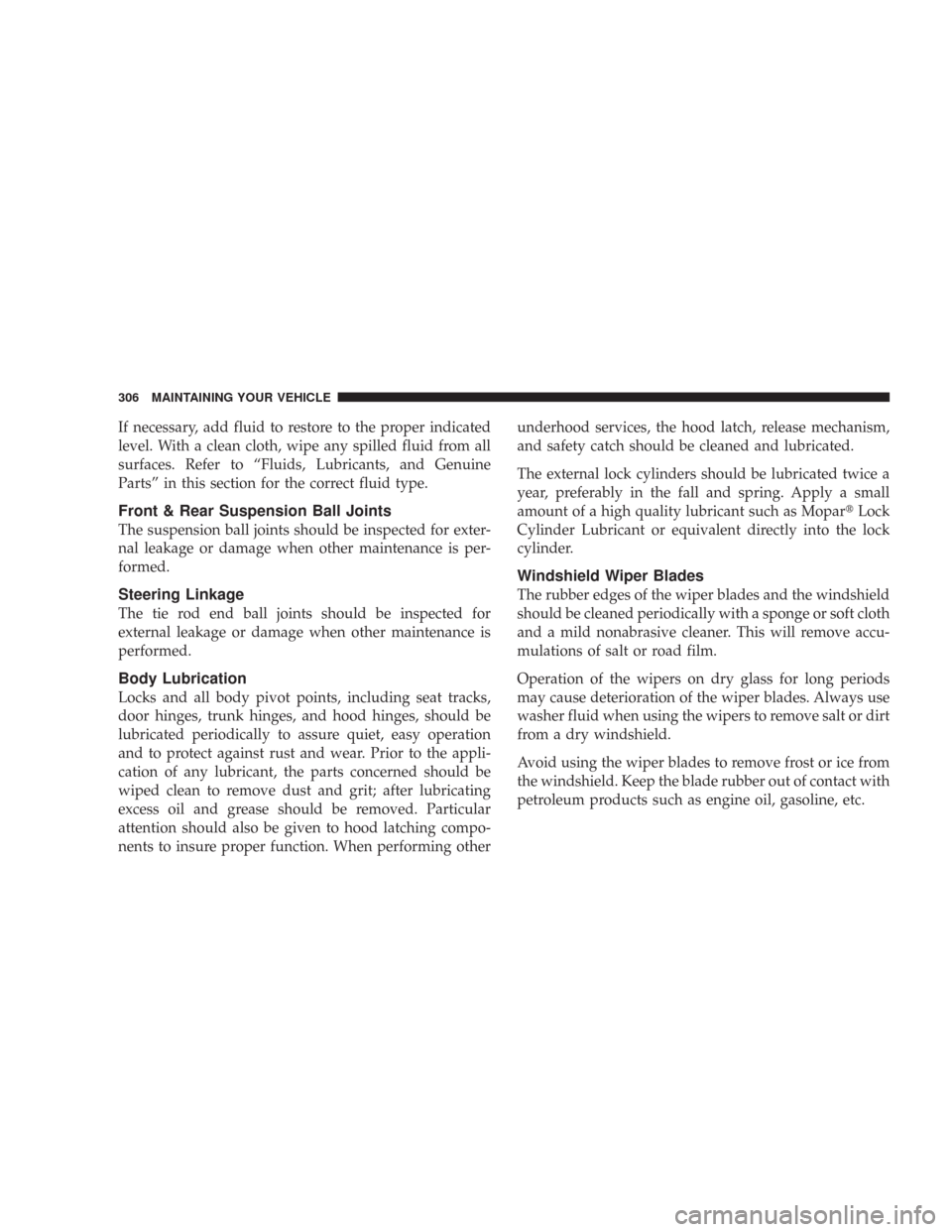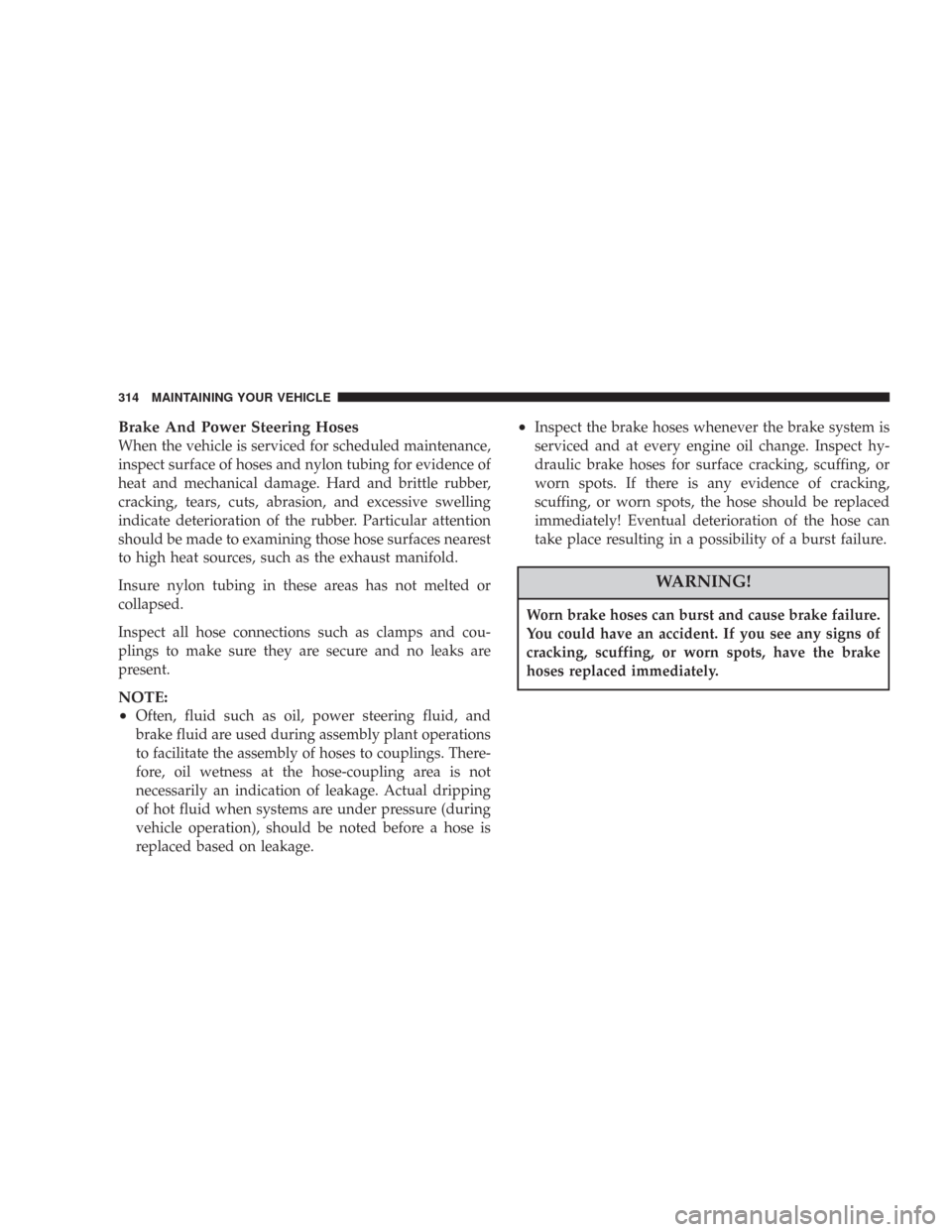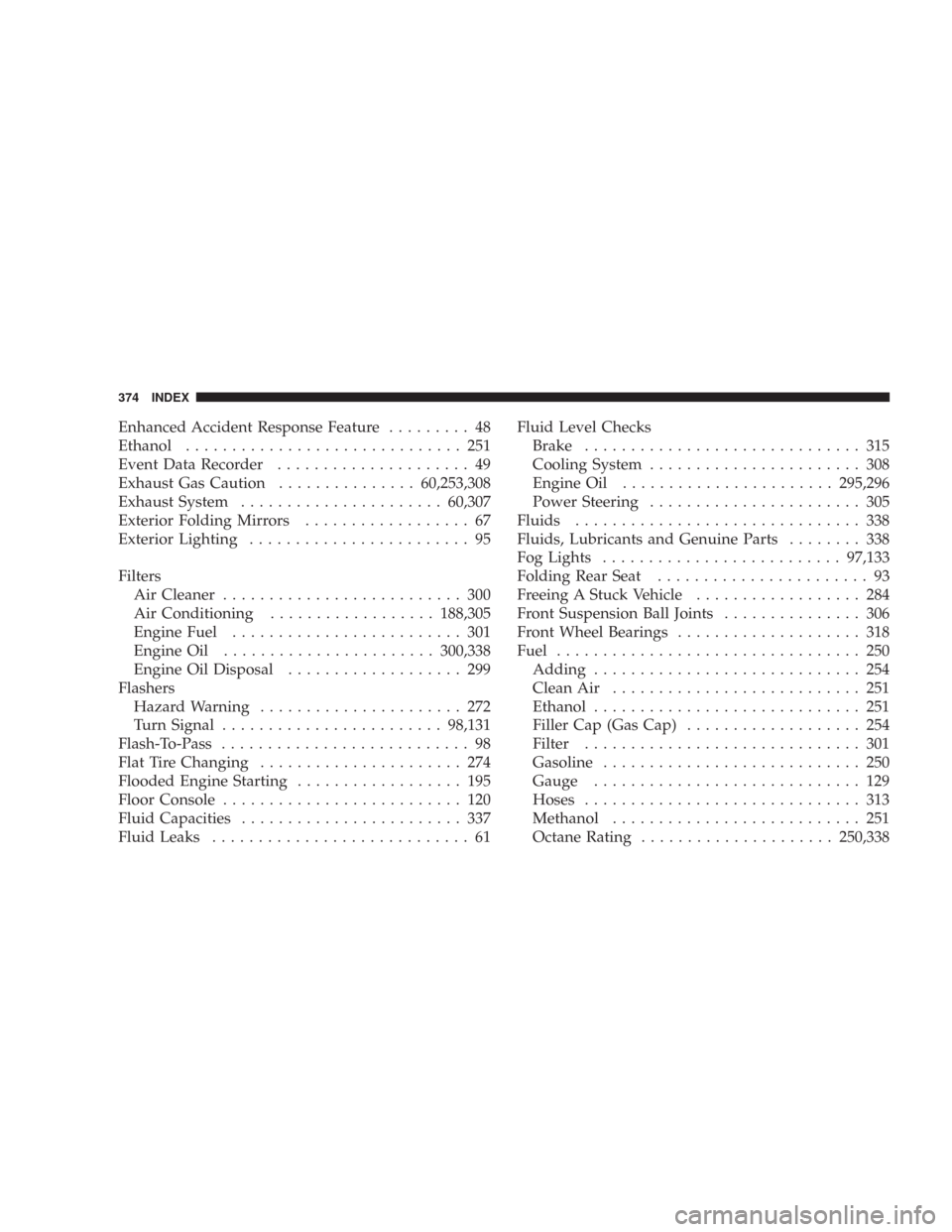Page 284 of 384

8. When removing the jumper cables, reverse the above
sequence exactly. Be careful of the moving belts and fan.
WARNING!
Any procedure other than above could result in:
1. Personal injury caused by electrolyte squirting
out the battery vent;
2. Personal injury or property damage due to battery
explosion;
3. Damage to charging system of booster vehicle or
of immobilized vehicle.
FREEING A STUCK VEHICLE
If your vehicle becomes stuck in mud, sand, or snow, it
can often be moved by a rocking motion. Turn your
steering wheel right and left to clear the area around the
front wheels. Then shift back and forth between Reverse
and Drive. Usually the least accelerator pedal pressure to
maintain the rocking motion without spinning the
wheels is most effective.
NOTE:Turn off the Electronic Stability Program (ESP)
— if equipped, or Traction Control System (TCS) — if
equipped before rocking the vehicle. For details, refer to
“Electronic Stability Program,” or “Traction Control Sys-
tem” in this manual.
284 WHAT TO DO IN EMERGENCIES
Page 287 of 384

MAINTAINING YOUR VEHICLE
CONTENTS
�2.7L Engine Compartment...............289
�3.5L Engine Compartment...............290
�5.7L Engine Compartment...............291
�Onboard Diagnostic System — OBD II......292
▫Loose Fuel Filler Cap..................293
�Emissions Inspection And
Maintenance Programs
..................293
�Replacement Parts.....................294
�Dealer Service........................294
�Maintenance Procedures.................295
▫Engine Oil..........................295
▫Engine Oil Filter......................300▫
Drive Belts — Check Condition And Tension...300
▫Spark Plugs.........................300
▫Engine Air Cleaner Filter................300
▫Fuel Filter..........................301
▫Catalytic Converter....................301
▫Maintenance-Free Battery................303
▫Air Conditioner Maintenance.............304
▫A/C Air Filter — If Equipped............305
▫Power Steering — Fluid Check............305
▫Front & Rear Suspension Ball Joints........306
▫Steering Linkage......................306
7
Page 305 of 384

Refrigerant Recovery and Recycling
R-134a Air Conditioning Refrigerant is a hydrofluorocar-
bon (HFC) that is endorsed by the Environmental Pro-
tection Agency and is an ozone-saving product. How-
ever, the manufacturer recommends that air conditioning
service be performed by dealers or other service facilities
using recovery and recycling equipment.
NOTE:Use only manufacturer approved A/C System
Sealers, Stop Leak Products, Seal Conditioners, Compres-
sor Oil, and Refrigerants.
A/C Air Filter — If Equipped
The filter is located in the fresh air inlet under the hood,
behind a removable panel in the cowl on the passenger
side of the vehicle, next to the windshield wipers. When
installing a new filter, ensure its proper orientation. To
replace the filter, remove the access door in the cowl
screen by pressing the retaining clips. Slide the lid on the
filter adapter forward and down and remove used filter.
Install new filter with arrows pointing in the direction of
airflow, which is toward the rear of the vehicle (text and
arrows on the filter indicate this).Refer to the “Maintenance Schedule” in this manual for
the recommended air conditioning filter replacement
intervals.
Power Steering — Fluid Check
Checking the power steering fluid level at a defined
service interval is not required. The fluid should only be
checked if a leak is suspected, abnormal noises are
apparent, and/or the system is not functioning as antici-
pated. Coordinate inspection efforts through a certified
DaimlerChrysler Dealership.
WARNING!
Fluid level should be checked on a level surface and
with the engine off to prevent injury from moving
parts and to insure accurate fluid level reading. Do
not overfill. Use only manufacturer’s recommended
power steering fluid.
MAINTAINING YOUR VEHICLE 305
7
Page 306 of 384

If necessary, add fluid to restore to the proper indicated
level. With a clean cloth, wipe any spilled fluid from all
surfaces. Refer to “Fluids, Lubricants, and Genuine
Parts” in this section for the correct fluid type.
Front & Rear Suspension Ball Joints
The suspension ball joints should be inspected for exter-
nal leakage or damage when other maintenance is per-
formed.
Steering Linkage
The tie rod end ball joints should be inspected for
external leakage or damage when other maintenance is
performed.
Body Lubrication
Locks and all body pivot points, including seat tracks,
door hinges, trunk hinges, and hood hinges, should be
lubricated periodically to assure quiet, easy operation
and to protect against rust and wear. Prior to the appli-
cation of any lubricant, the parts concerned should be
wiped clean to remove dust and grit; after lubricating
excess oil and grease should be removed. Particular
attention should also be given to hood latching compo-
nents to insure proper function. When performing otherunderhood services, the hood latch, release mechanism,
and safety catch should be cleaned and lubricated.
The external lock cylinders should be lubricated twice a
year, preferably in the fall and spring. Apply a small
amount of a high quality lubricant such as Mopar�Lock
Cylinder Lubricant or equivalent directly into the lock
cylinder.
Windshield Wiper Blades
The rubber edges of the wiper blades and the windshield
should be cleaned periodically with a sponge or soft cloth
and a mild nonabrasive cleaner. This will remove accu-
mulations of salt or road film.
Operation of the wipers on dry glass for long periods
may cause deterioration of the wiper blades. Always use
washer fluid when using the wipers to remove salt or dirt
from a dry windshield.
Avoid using the wiper blades to remove frost or ice from
the windshield. Keep the blade rubber out of contact with
petroleum products such as engine oil, gasoline, etc.
306 MAINTAINING YOUR VEHICLE
Page 314 of 384

Brake And Power Steering Hoses
When the vehicle is serviced for scheduled maintenance,
inspect surface of hoses and nylon tubing for evidence of
heat and mechanical damage. Hard and brittle rubber,
cracking, tears, cuts, abrasion, and excessive swelling
indicate deterioration of the rubber. Particular attention
should be made to examining those hose surfaces nearest
to high heat sources, such as the exhaust manifold.
Insure nylon tubing in these areas has not melted or
collapsed.
Inspect all hose connections such as clamps and cou-
plings to make sure they are secure and no leaks are
present.
NOTE:
•
Often, fluid such as oil, power steering fluid, and
brake fluid are used during assembly plant operations
to facilitate the assembly of hoses to couplings. There-
fore, oil wetness at the hose-coupling area is not
necessarily an indication of leakage. Actual dripping
of hot fluid when systems are under pressure (during
vehicle operation), should be noted before a hose is
replaced based on leakage.
•Inspect the brake hoses whenever the brake system is
serviced and at every engine oil change. Inspect hy-
draulic brake hoses for surface cracking, scuffing, or
worn spots. If there is any evidence of cracking,
scuffing, or worn spots, the hose should be replaced
immediately! Eventual deterioration of the hose can
take place resulting in a possibility of a burst failure.
WARNING!
Worn brake hoses can burst and cause brake failure.
You could have an accident. If you see any signs of
cracking, scuffing, or worn spots, have the brake
hoses replaced immediately.
314 MAINTAINING YOUR VEHICLE
Page 327 of 384
Cavity Car-
tridge
FuseMini
FuseDescription
17 — 20 Amp
YellowCluster
18 — 20 Amp
YellowSelectable Power Outlet
19 — 10 Amp
RedStop Lights
20———
21———
22———
23———
24———
25———
26———
27 — 10 Amp
RedAirbag/Airbag Control
Module (ACM)
28 — 10 Amp
RedCurtain Airbag - if
equippedCavity Car-
tridge
FuseMini
FuseDescription
29 — 5 Amp
OrangeAnti-lock Brakes Module
- if equipped/Cluster/
Front Control Module
(FCM)/Powertrain Con-
trol Module (PCM)/
Sentry Key Remote Key-
less Entry/Stop Lights
30 — 10 Amp
RedDoor Modules/Power
Mirrors - if equipped/
Steering Control Module
31———
32———
33———
34———
MAINTAINING YOUR VEHICLE 327
7
Page 339 of 384
Chassis
Component Fluids, Lubricants and Genuine Parts
Automatic Transmission Mopar�ATF+4 Automatic Transmission Fluid.
Brake Master Cylinder Mopar�DOT 3, SAE J1703 should be used. If DOT 3, SAE J1703 brake
fluid is not available, then DOT 4 is acceptable. Use only recommended
brake fluids.
Front Axle API Certified GL-5 SAE 75W90 Synthetic Gear Lubricant or equivalent.
Power Steering Reservoir Mopar�Power Steering Fluid + 4, Mopar�ATF+4 Automatic Transmission
Fluid.
Rear Axle API Certified GL-5 SAE 75W140 Synthetic Gear Lubricant or equivalent.
Transfer Case Mopar�Transfer Case Lubricant LX, P/N 05170055AA, or equivalent.
MAINTAINING YOUR VEHICLE 339
7
Page 374 of 384

Enhanced Accident Response Feature......... 48
Ethanol.............................. 251
Event Data Recorder..................... 49
Exhaust Gas Caution...............60,253,308
Exhaust System......................60,307
Exterior Folding Mirrors.................. 67
Exterior Lighting........................ 95
Filters
Air Cleaner.......................... 300
Air Conditioning..................188,305
Engine Fuel......................... 301
Engine Oil.......................300,338
Engine Oil Disposal................... 299
Flashers
Hazard Warning...................... 272
Turn Signal........................98,131
Flash-To-Pass........................... 98
Flat Tire Changing...................... 274
Flooded Engine Starting.................. 195
Floor Console.......................... 120
Fluid Capacities........................ 337
Fluid Leaks............................ 61Fluid Level Checks
Brake.............................. 315
Cooling System....................... 308
Engine Oil.......................295,296
Power Steering....................... 305
Fluids............................... 338
Fluids, Lubricants and Genuine Parts........ 338
Fog Lights..........................97,133
Folding Rear Seat....................... 93
Freeing A Stuck Vehicle.................. 284
Front Suspension Ball Joints............... 306
Front Wheel Bearings.................... 318
Fuel................................. 250
Adding............................. 254
Clean Air........................... 251
Ethanol............................. 251
Filler Cap (Gas Cap)................... 254
Filter.............................. 301
Gasoline............................ 250
Gauge............................. 129
Hoses.............................. 313
Methanol........................... 251
Octane Rating.....................250,338
374 INDEX